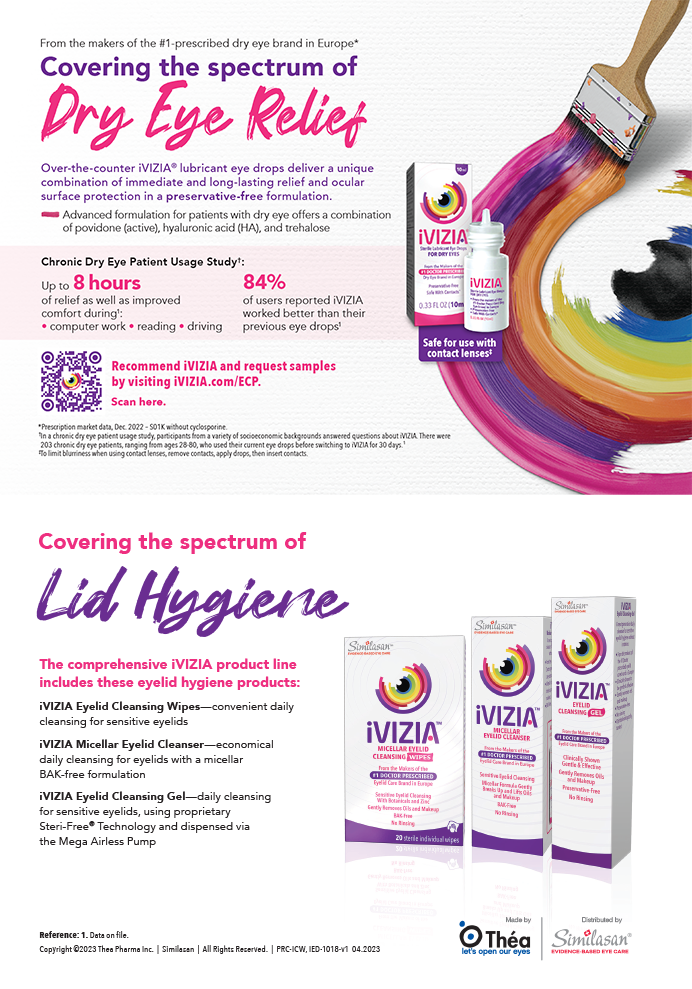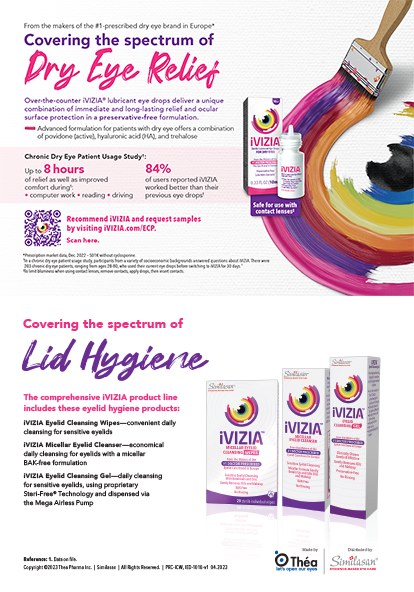CASE PRESENTATION
A 57-year-old woman presents with a history of bilateral LASIK using a Summit Laser and a mechanical microkeratome in 1996. Her original refraction was -12.5 +1 X 80 = 20/25 OD and -13 +1 X 85 = 20/25 OS. Her original computed topography was normal with regular with-the-rule astigmatism. The original keratometry readings were 46.10@90/44.75@180 OD and 47.00@80/45@170. Her original pachymetry readings were 475 μm OD and 485 μm OS. In 1997, the patient underwent a LASIK enhancement of her left eye. The surgeon lifted the flap and treated -0.5 +1 X 65. She had no problems with her vision until 2003, when her refraction measured -1.5 +0.25 X 29 OS for 20/30 BCVA. Early signs of ectasia were present based on serial tomography and topography. The patient discussed her options with the surgeon, but she was using her left eye for monovision without incident (Figure 1).
The patient continued to show changes in keratometry and refraction. In 2004, she was referred for corneal collagen cross-linking (CXL) with riboflavin and the placement of Intacs (Addition Technology, Inc.). She underwent the procedure without difficulty, and Figure 2 shows her postoperative result by computed topography. Her refraction in 2006 was +0.75 +0.25 X 45, with a BCVA of 20/20 and a UCVA of 20/40+2.
The patient routinely returned for observation and was happy with her vision until she saw her ophthalmologist on June 17, 2011. Her left eye's manifest refraction was +1.25 +0.25 X 22, with a BCVA of 20/50. A slit-lamp examination revealed peripheral cortical changes and a posterior subcapsular cataract. Figure 3 shows her current computed topography. The slit-lamp and retinal examinations were otherwise normal.
The patient presents to you for cataract surgery on her left eye. How would you proceed? Would you require any additional tests or information for her treatment?
ARTHUR CUMINGS, FRCSEd
This case typifies what lies in wait for all of us cataract and refractive surgeons. Around 30 million LASIK and PRK procedures have been performed worldwide, and many of the patients are now presenting to us for cataract surgery. As all of us know, IOL power calculations are a challenge in this population. The situation is even more complex here.
The Intacs and CXL did not drastically change the corneal curvature: it has flattened by a diopter only. Complicating matters, however, is that the initial refractive error was very high myopia. A further challenge is that not much corneal tissue remains for refinements with laser refractive surgery. There is therefore a strong imperative to get the IOL calculations as accurate as possible the first time. One last thought in general terms: because the cornea is currently quite flat, if any further laser treatment were required, I would prefer to target hyperopia for two reasons. First, it would steepen the cornea. Second, it would not remove any central corneal tissue where it is thinnest. I should note that, when I refer to a hyperopic treatment, I mean a low magnitude of error—in the order of 1.00 to 1.50 D at most, if at all possible.
Several approaches are options, depending on the technology available. Biometry is required for the IOL power calculation. Measurements could be performed with the IOLMaster (Carl Zeiss Meditec, Inc.) or Lenstar LS900 (Haag-Streit AG) using the Holladay EKR keratometry readings, with the power confirmed against the ASCRS postrefractive surgery calculator. I am involved in a research group (ClearSight) that is using ray tracing for challenging eyes such as this one, and I would certainly run this case by my colleagues. Another approach that might prove useful, however, is intraoperative aberrometry (ORA System; WaveTec Vision).
If all of the calculated IOL powers matched, there would not be much to discuss. If they differed, I would choose the IOL that would leave the eye slightly hyperopic (weaker-powered IOL) if the target were emmetropia. If the patient wished to use this eye for reading vision, I would use the average IOL power obtained by the methods employed. A last rule of thumb in these very complicated eyes is that, in my experience, the IOL will not be too far from 18.00 D. If I had no access to any measurements, I would choose this power. Obviously, that does not always work, or there would not be much to say about this particular case!
I would warn the patient that she will likely require further surgery after the IOL procedure. This might include laser refractive surgery, an IOL exchange, and possibly the use of a supplementary pseudophakic IOL such as the Sulcoflex (Rayner Intraocular Lenses Ltd.; not available in the United States).
A. JOHN KANELLOPOULOS, MD
It appears that this lady was 42 years old at the time of her surgery in 1996 and that she had -12.50 D of myopia in her right eye and -13.00 D in her left eye. Based on this information and her corneal pachymetry measurements, I cannot help but wonder if she would be considered a good candidate for LASIK today or perhaps LASIK with prophylactic CXL.
Today, the regression noted in the presentation would raise a suspicion of ectasia and prompt an extensive evaluation of biomechanics and corneal tomography. It appears that the patient again experienced regression 6 years after her enhancement, with another 1.50 D and 0.25 D of astigmatism. Actually, I am not sure that Figure 1 shows the early signs of ectasia. (After LASIK, I do not pay much attention to the posterior float, owing to potential bias with the Orbscan [Bausch + Lomb] and Pentacam Comprehensive Eye Scanner [Oculus Optikgeräte GmbH]. Moreover, based on the corneal topography provided, the ablated area appears to be symmetrical. It is therefore unclear if, in 2003, this eye had ectasia or perhaps early nuclear sclerosis.
Nowadays, I would pay more attention to the changes in the crystalline lens, because in my experience, patients—especially women—with very high myopia tend to develop cataracts earlier in life than other individuals. I would have discussed this with the patient, because she otherwise might interpret later myopic regression as a failure of the laser refractive procedure. That surgery, in my opinion, appears to have been performed perfectly.
The corneal topography appears to be stable, and the peripheral retinal examination was normal. Prior to cataract surgery, I would want to obtain an endothelial cell count, because this eye has undergone two LASIK procedures and CXL. Because this patient has doubtless enjoyed emmetropia in place of her congenital high myopia, she would be extremely dissatisfied with a hyperopic or myopic result. I would therefore devote a great deal of time to explaining to her the limitations of cataract surgery compared with LASIK in terms of the refractive result.
The most difficult task would be the IOL power calculation. Several formulas have been developed for use after LASIK. In high myopes, I expect an axial length of 28 to 29 mm. In my experience with cases such as this one, calculating the IOL's power with topographic data yields 1.00 to 2.00 D of hyperopia postoperatively. I would therefore perform a power calculation using either the IOLMaster or the Wavelight Biograph (Alcon Laboratories, Inc.; not available in the United States) and then add 2.00 D. I believe an emmetropic or even slightly myopic result would be perfect for this patient.
I would not consider a multifocal lens for her for four reasons. First is that she requires cataract surgery in only one eye. Second is the imprecision of the IOL power calculation. Third is the eye's significant spherical aberration after LASIK. Fourth, due to the congenital high myopia, the patient probably has a significant angle kappa. Instead, if the corneal cylinder were greater than 0.75 D, I would implant the AcrySof IQ Toric IOL (Alcon Laboratories, Inc.).
ROY S. RUBINFELD, MD
Unlike most patients in the United States, this woman was able to access CXL with UVA-riboflavin in 2004. This procedure likely halted the progression of her irregular astigmatism and her loss of vision and explains her current refractive stability. The implanted corneal ring segment likely was also useful in regularizing the corneal shape and improving her vision.
This patient would have continued to do well had she not developed a cataract. Her corneal curvature and refractive status complicate the IOL power calculation and will make it difficult, if not impossible, to achieve an emmetropic result. Regardless of the method of calculation used, the surgeon will have to counsel the patient about her need for spectacle and/or contact lens correction after cataract surgery.
With other patients who have undergone refractive surgery, it is often easy to lift the flap for a LASIK enhancement or to perform PRK to achieve excellent unaided vision after cataract surgery. Almost no one would lift this patient's flap, and PRK carries its own set of risks. As is often the case, an important part of good clinical practice is making certain the patient understands the limitations of any treatment. Outside the United States, topographyguided PRK might be a reasonable option, but like CXL, this technology is not yet available here.
Editor's note: The FDA has not approved CXL.
Section Editor Stephen Coleman, MD, is the director of Coleman Vision in Albuquerque, New Mexico. Parag A. Majmudar, MD, is an associate professor, Cornea Service, Rush University Medical Center, Chicago Cornea Consultants, Ltd. Karl G. Stonecipher, MD, is the director of refractive surgery at TLC in Greensboro, North Carolina. Dr. Stonecipher may be reached at (336) 288-8523; stonenc@aol.com.
Arthur Cummings, FRCSEd, is a consultant ophthalmologist at Wellington Eye Clinic in Dublin, Ireland. Mr. Cummings is an associate chief medical editor of Cataract & Refractive Surgery Today Europe. He is a consultant to Alcon Laboratories, Inc., and WaveLight Laser Technologie AG. Mr. Cummings may be reached at +353 1 2930470; abc@wellingtoneyeclinic.com.
A. John Kanellopoulos, MD, is the director of the LaserVision.gr Eye Institute in Athens, Greece; an attending surgeon at the Department of Ophthalmology, Manhattan Eye, Ear, and Throat Hospital in New York; and a clinical professor of ophthalmology at New York University Medical School in New York. He acknowledged no financial interest in the products or companies he mentioned. Dr. Kanellopoulos may be reached at +30 21 07 47 27 77; ajkmd@mac.com.
Roy S. Rubinfeld, MD, is in private practice with Washington Eye Physicians & Surgeons in Chevy Chase, Maryland. He is also a clinical associate professor of ophthalmology at Georgetown University Medical Center and Washington Hospital Center in Washington, DC. He has proprietary interests in the CXL space. Dr. Rubinfeld may be reached at (301) 657-5711; rubinkr1@aol.com.


